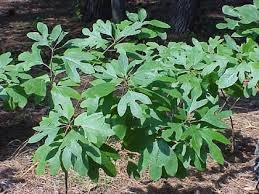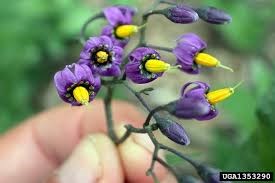It seems an extraordinary natural occurrence is required to untangle me from the vines of various issues to present more great edible and medicinal plants that literally sprout from the cracks of Brooklyn's cement. Yes, it takes the big bold Harvest Moon and the eclipse. This herb witch in training offers four more plants to showcase: Bittersweet Nightshade, Plantain Leaf, Sweet Gum Tree, and Sassafras Bush.
Bittersweet Night Shade (Solanum dulcamara) is found growing in a tangle on chain link fences and

on the ground. This plant is a vine with small green leaves, delicate little violet flowers with yellow pistils, and diminutive red berries filled with many seeds that look very much like tomatoes. Bittersweet Nightshade is toxic to eat. It is used for such skin conditions as calluses and warts. Pop open one or two berries and place it on the callus to allow the liquid to soak into the callus and surrounding area but, have it dripping off the area for treatment.
After several minutes (7 to 15 minutes), remove the berry and stray seeds. Depending on the size of the callus or wart, one may see a visible shrinkage of the growth. Remember, nature takes it time, therefore, do several applications over a course of weeks where, in all cases, the opened berry or berries cover the affected area for several minutes. Bandaging the area will keep the berry in place, but will absorb the berry juice.

Plantain Leaf, also called White Man's Foot (Plantago major), grows as profusely as white clover and dandelion. It is an oval-shaped green leaf with veins running vertically through it. Another variety of it is a slender leaf. In the spring the oval kind have a rounder shape (the way many infant beings appear) and about one inch in length. By late fall, the leaves are at least three inches long and sharing space with much longer narrow seed stalks. These seeds are psyllium which is one of the active ingredients in bowel cleansers. Chew a few stalks-grinding each one carefully—and later, drink a tall glass of water to experience psyllium's effectiveness.

Plantain is healing and soothing for such eye problems as eye fatigue and conjunctivitis or Pink Eye. The leaves are steeped in boiling hot water for a few hours for optimal extraction of its active ingredients. Its juice is excellent for insect bites, skin abrasions and anti-inflammatory aiding in rashes, cramps, and hemorrhoids.
Rich in Silica, it is an edible plant that would make a tasty addition to salads. By late fall, the mature plant is a bit tough to chew. Cooking it in water for a few minutes tenderizes it and gives the leaf a look similar to sea vegetables. Try seasoning it with ginger, soy sauce, and garlic; then serve it to guests. Watch how many will be surprised that they are eating the weed Plantain and not Nori or Wakame.

Sweet Gum Tree: Ever notice the spiky balls that fall from a tall tree? Those are Sweet Gum (Liquidambar styraciflua) tree seed pods. The resin from this tree is chewy like chewing gum and mildly bitter. It is also soothing for sore throat. The bark is astringent; therefore, a skin toner is made by boiling the bark in water. Adding a squirt of fresh lime or lemon juice or whipped Aloe Vera gel, boosts the skin toning effect. Sweet gum tree tea is effective relief from the Flu.

The Sassafras Tree (Sassafras albidum) distinguishes itself by growing three distinctive leaves throughout it: One leaf is shaped like a trident; another leaf looks like a catcher's mitt and the other is oval-shaped. If all three leaf shapes are not found on the tree, then the seeker has not come upon a Sassafras tree. This tree can be mistaken for a bush during its first years of growth. Sassafras is considered a spring tonic by some herbalists. This tonic is made by boiling the bark of the root or steeping the leaves in boiling hot water. It is good for the stomach and purifies the blood. Sassafras is the flavor associated with manufactured root beer sodas.




